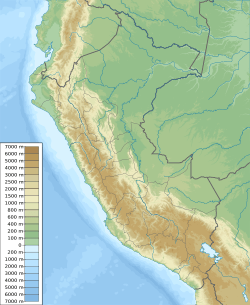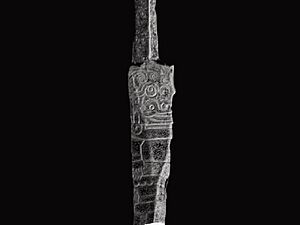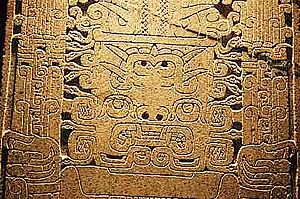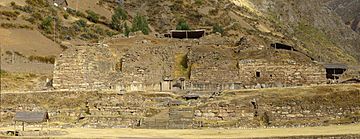Chavín de Huántar facts for kids

Overview of Chavín de Huántar
|
|
| Location | Ancash Region, Peru |
|---|---|
| Coordinates | 9°35′34″S 77°10′42″W / 9.59278°S 77.17833°WCoordinates: 9°35′34″S 77%10′42″W / 9.59278°S 77.17833°W |
| Height | 3,180 metres (10,430 ft) |
| History | |
| Founded | Before 1200 BC |
| Cultures | Chavín culture |
| Site notes | |
| UNESCO World Heritage Site | |
| Official name | Chavín (Archaeological Site) |
| Criteria | Cultural: (iii) |
| Inscription | 1985 (9th Session) |
| Area | 14.79 ha (36.5 acres; 1,592,000 sq ft) |
Chavín de Huántar is an amazing archaeological site in Peru. It holds ancient ruins and artifacts built by the Chavín people. They lived there from as early as 1200 BC until about 400–500 BC. The Chavín were a very important culture before the famous Inca.
This special site is located in the Ancash Region of Peru. It's about 434 kilometers (270 miles) north of Lima. The site sits high up at 3,180 meters (10,430 feet) above sea level. It's found east of the Cordillera Blanca mountains, right at the start of the Conchucos Valley.
Chavín de Huántar is so important that UNESCO has named it a World Heritage Site. Some of the cool items found here are shown in museums. You can see them at the Museo de la Nación in Lima or the Museo Nacional de Chavín in Chavín itself.
People lived at Chavín de Huántar as early as 3000 BC. The main religious activities happened later, from the end of the second millennium BC through the middle of the first millennium BC. The people mostly farmed for food. But the city's location was perfect for sharing ideas and goods. It was between the coast and the jungle, near the start of the Marañón River.
This large ceremonial center has taught us a lot about the Chavín culture. Chavín de Huántar was a meeting place where people came to worship. It became a very important place for the whole region. People visited to take part in rituals, ask an oracle for advice, or join a religious group.
Around 500 to 300 BC, the Chavín culture started to decline. At Chavín de Huántar, things changed too. A small village replaced the Circular Plaza by 500 BC. People from later groups lived there and even reused stones from the old buildings for their homes. This village was lived in continuously until the 1940s.
Contents
Exploring the Ancient Site
The Chavín civilization was centered around Chavín de Huántar. This was their main religious and political hub. The temple here is a huge, flat-topped pyramid. It is surrounded by lower platforms and has a U-shaped plaza with a sunken circular court in the middle. The temple walls inside are covered with amazing sculptures and carvings.
In its best days, Chavín de Huántar was a busy religious center. It was used for ceremonies and events. It might have even been home to an oracle, someone who could tell the future. The site has several big structures, like Temples A, B, C, and D. There are also areas called the Major Plaza and the Circular Plaza.
Chavín de Huántar was built in many steps. Construction started before 1200 BC, and most of the big buildings were finished by 750 BC. The site continued to be used for ceremonies until about 500 BC. However, its main religious purpose ended before 400 BC. After that, people from a different culture, the Huaraz tradition, started living there more often.
The "Circular Plaza" was a very important open-air space for rituals. Before 800–700 BC, it had different uses. It even served as an entrance area for Temple A. After 700 BC, this plaza was surrounded by the big Temples A, B, and C. It is perfectly round, about 20 meters (66 feet) across. Its floor was made of yellow diatomite stones. A line of black limestone blocks runs through its center. The plaza walls were built with carefully cut granite stones.
The "Old Temple" was built early in the site's history. It was a structure with many passageways built around a circular courtyard. Inside, there were tall stone monuments called obelisks and carvings. These carvings showed jaguars, caimans, and other creatures that looked part animal, part human. At the very center was the Lanzón Gallery. It held a sculpture called the Lanzón, which people believe was the most important god of Chavín de Huántar. This figure has a feline (cat-like) head and a human body.
Archaeologists also found mortars, pestles, conch-shell trumpets, and other items. Many of these artifacts have human-like designs. They are thought to have been used in Chavín rituals.
The "New Temple" was built between 500 and 200 BC. It also had galleries and plazas with many relief sculptures. The Lanzón god is shown here holding a strombus shell in one hand and a Spondylus shell in the other. These shells were considered sacred.
The design of Chavín de Huántar changed over time. The old temple was added to, and a new temple was built. Smaller changes happened often until about 500 BC, when the new temple was finished. The old temple had a simple U-shaped design with a sunken circular plaza. This was common for ceremonial centers during that time.
After the new temple was finished, Chavín de Huántar still kept its U-shaped design. The changes made the site much larger. They also added a bigger, sunken rectangular plaza. The main goal of these changes seemed to be to allow more people to gather in one place.
Digging up burial sites has shown that there was a small group of important people. Their tombs had fancy items like precious metals, colorful textiles, and other valuable things. Most burials were simpler. Bodies were placed in shallow pits, dressed in cotton clothes, and had a basic tool kit.
The art and decorations of the Chavín people used scrolls, simple curves, straight lines, and images of wild animals. Chavín sculptures were usually made from white granite and black limestone. Carved stone mortars and pestles, conch-shell trumpets, and metal tools were found with Chavín designs. Various tapestries were also found. Pottery came in many shapes, like bottles and bowls, and had a wide range of unique decorations.
Why Chavín de Huántar is Important
In the early 1900s, a Peruvian archaeologist named Julio C. Tello called this site "the birthplace of South American culture." He believed it was the oldest and most powerful center of the Chavín culture in the highlands. Chavín de Huántar is located north of modern-day Lima. It sits where two rivers, the Mosna and the Huanchecsa, meet. This spot made it easy to get there by water, but also kept outsiders from easily reaching it.
However, newer discoveries have shown that the Norte Chico (also called Caral-Supe) was actually the first civilization in the Americas and Peru. This older civilization is about 5,000 years old. It covered an area across four river valleys, about 100 miles north of Lima.
Chavín de Huántar is in a valley where the Mosna and Huanchecsa rivers meet. There are also high-altitude valleys nearby. This meant the people could grow both lowland crops like maize (corn) and high-altitude crops like potatoes. They also raised llamas in the mountains for food and to carry heavy loads on the steep hills.
The religious importance of Chavín de Huántar was linked to its geography. Many cultures believe that where two large rivers meet has spiritual meaning. This meeting of two rivers is called tinkuy. It means the peaceful coming together of opposing forces. People likely thought Chavín de Huántar was a meeting place for natural and cosmic powers. The area also has natural hot springs and an amazing view of the Wantsan peak. These features probably added to the site's religious significance.
Ancient Religious Practices
Archaeologists are still trying to figure out the religious practices at Chavín de Huántar when it was most active. In the 1970s, Peruvian archaeologist Luis Lumbreras visited the site. He learned some local stories. People believed the word Chavín came from the Quechua word chaupin, meaning "center." This shows how important the site was to local communities.
Lumbreras thought that the leaders of the communities might have created the rituals at the site. He also believed they might have convinced people to come to the temple. This would help them keep their power and social order.
Recent Discoveries
In the early 2000s, John Rick and his team from Stanford University came to similar ideas about how religious practices developed. Rick believes that the priests at the temple used clever techniques, special items, and complex building designs to gain followers. These ideas suggest that the temple and its priests had a lot of power over local communities during its peak.
Rick also used laser scanning to study the site. He wanted to see if it was "planned by leaders or came from a strong religious feeling among the people." This technology helped create digital maps of the site. Because details like stair placement stayed the same over many generations of builders, the site might be an early example of a standard building code.
Since 2004, the Global Heritage Fund (GHF) has been working to preserve this UNESCO World Heritage Site. They also help train local people and develop their skills. The GHF's work includes:
- Making the main buildings stable.
- Fixing underground structures.
- Mapping the site with very accurate tools.
- Finding hidden underground structures without digging.
- Uncovering and, if needed, removing later buildings to show the original architecture.
- Listing all the artifacts.
- Making the site easier for visitors to understand.
- Involving the local community through training, jobs, and tourism.
CyArk has created a slideshow, maps, and 3-D presentations about Chavín de Huántar. These are based on their laser scanning and digital preservation project from 2005–2006.
In 2018, Rick's team used special robots to explore the temple. They found 30 tunnels and the graves of several people buried under rocks. More research is needed to study these human remains and any items buried with them.
Images for kids
See also
 In Spanish: Chavín de Huántar para niños
In Spanish: Chavín de Huántar para niños










